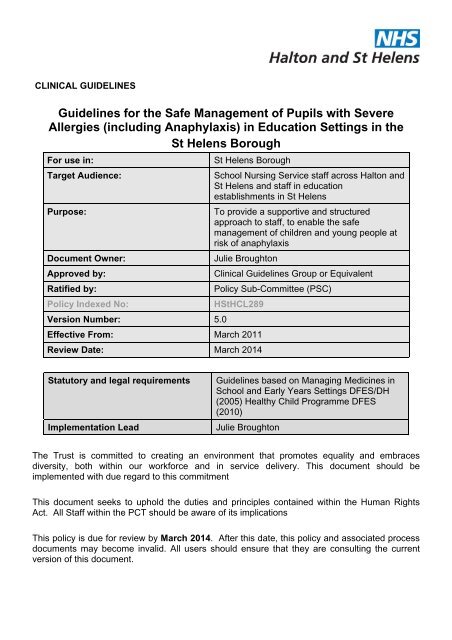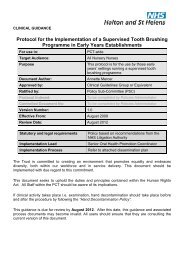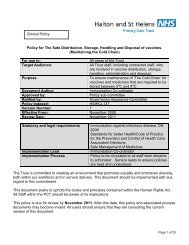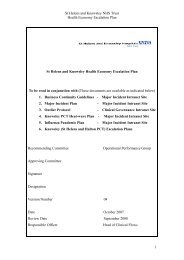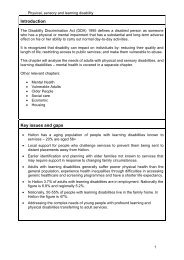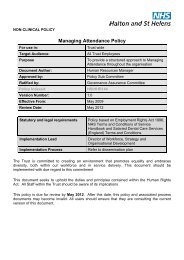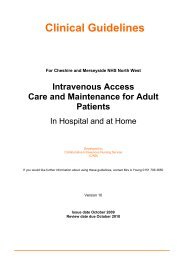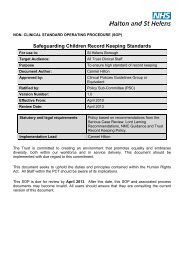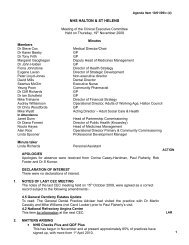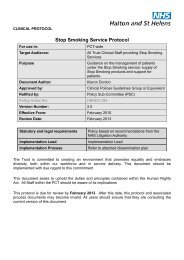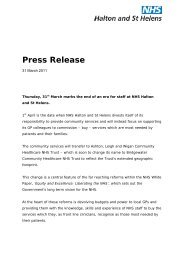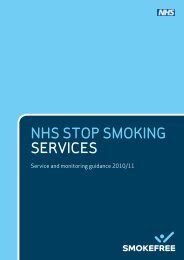Guidelines for the Safe Management of Pupils with Severe Allergies ...
Guidelines for the Safe Management of Pupils with Severe Allergies ...
Guidelines for the Safe Management of Pupils with Severe Allergies ...
Create successful ePaper yourself
Turn your PDF publications into a flip-book with our unique Google optimized e-Paper software.
CLINICAL GUIDELINES<br />
<strong>Guidelines</strong> <strong>for</strong> <strong>the</strong> <strong>Safe</strong> <strong>Management</strong> <strong>of</strong> <strong>Pupils</strong> <strong>with</strong> <strong>Severe</strong><br />
<strong>Allergies</strong> (including Anaphylaxis) in Education Settings in <strong>the</strong><br />
St Helens Borough<br />
For use in:<br />
St Helens Borough<br />
Target Audience:<br />
School Nursing Service staff across Halton and<br />
St Helens and staff in education<br />
establishments in St Helens<br />
Purpose:<br />
To provide a supportive and structured<br />
approach to staff, to enable <strong>the</strong> safe<br />
management <strong>of</strong> children and young people at<br />
risk <strong>of</strong> anaphylaxis<br />
Document Owner:<br />
Julie Broughton<br />
Approved by:<br />
Clinical <strong>Guidelines</strong> Group or Equivalent<br />
Ratified by:<br />
Policy Sub-Committee (PSC)<br />
Policy Indexed No:<br />
HStHCL289<br />
Version Number: 5.0<br />
Effective From: March 2011<br />
Review Date: March 2014<br />
Statutory and legal requirements<br />
Implementation Lead<br />
<strong>Guidelines</strong> based on Managing Medicines in<br />
School and Early Years Settings DFES/DH<br />
(2005) Healthy Child Programme DFES<br />
(2010)<br />
Julie Broughton<br />
The Trust is committed to creating an environment that promotes equality and embraces<br />
diversity, both <strong>with</strong>in our work<strong>for</strong>ce and in service delivery. This document should be<br />
implemented <strong>with</strong> due regard to this commitment<br />
This document seeks to uphold <strong>the</strong> duties and principles contained <strong>with</strong>in <strong>the</strong> Human Rights<br />
Act. All Staff <strong>with</strong>in <strong>the</strong> PCT should be aware <strong>of</strong> its implications<br />
This policy is due <strong>for</strong> review by March 2014. After this date, this policy and associated process<br />
documents may become invalid. All users should ensure that <strong>the</strong>y are consulting <strong>the</strong> current<br />
version <strong>of</strong> this document.
Key individuals involved in developing <strong>the</strong> document (Internal Staff Only)<br />
Name(s)<br />
Designation<br />
Julie Broughton<br />
Louise Gettings<br />
Margaret Gorst<br />
Team Co-ordinator School Nursing<br />
School Nurse<br />
School Nurse<br />
Distributed to <strong>the</strong> following <strong>for</strong> approvals and comments<br />
Committee(s)<br />
Members <strong>of</strong> <strong>the</strong> Policy Sub Committee (PSC)<br />
Members <strong>of</strong> <strong>the</strong> Clinical Policies <strong>Guidelines</strong><br />
Group (CPG)<br />
Individual(s) (Include email address <strong>of</strong> external<br />
individuals (NON NHS))<br />
Designation<br />
Lesley Brownlow<br />
Roslyn Connolly<br />
Dr Laweh Amegavie<br />
Michele Harrop<br />
Dot Keates<br />
Susan Richardson –<br />
Susan.Richardson@s<strong>the</strong>lens.gov.uk<br />
Christine Williams<br />
Christine.Williams@s<strong>the</strong>lens.gov.uk<br />
Stuart Pennington –<br />
Stuart.Pennington@s<strong>the</strong>lens.gov.uk<br />
Stephen McDowell<br />
Gill Clare<br />
Debbie Fairclough<br />
Ca<strong>the</strong>rine Clegg – www.hilldickinson.com<br />
School Nurse Lead<br />
Assistant Director Child and Family Health<br />
Consultant Paediatritian (Respiratory Lead)<br />
Whiston Hospital<br />
Paediatric Respiratory Nurse Specialist<br />
Whiston Hospital<br />
Pr<strong>of</strong>essional Development Lead<br />
Director <strong>of</strong> Children and Young People’s<br />
Service St Helens<br />
Senior Assistant Director <strong>of</strong> Children and<br />
Families<br />
Risk Assessment Manager St Helens<br />
Council<br />
CPR/First Aid Training Manager<br />
Senior Pharmacist ( Medicines Governance)<br />
Assistant Chief Executive Halton and St<br />
Helens PCT<br />
Hill Dickinson LLP<br />
Page 2 <strong>of</strong> 26
Revision History and Version Control<br />
Revision<br />
Date<br />
Reason <strong>for</strong> Change Version No. By Who Version No.<br />
October<br />
2008<br />
January<br />
2009<br />
First Issue 1.0 Julie<br />
Broughton<br />
Document review 2.0 Julie<br />
Broughton<br />
May 2009 Document review 3.0 Julie<br />
Broughton<br />
March 2010 Document review 4.0 Julie<br />
Broughton<br />
March 2011 Document review 5.0 Julie<br />
Broughton<br />
1.0<br />
2.0<br />
3.0<br />
4.0<br />
5.0<br />
Page 3 <strong>of</strong> 26
Table <strong>of</strong> Contents<br />
Introduction ..................................................................................................................................5<br />
Purpose........................................................................................................................................5<br />
Objectives .................................................................................................................................5<br />
Outcomes..................................................................................................................................6<br />
Scope...........................................................................................................................................6<br />
Background..................................................................................................................................6<br />
Duties and Responsibilities ..........................................................................................................7<br />
Duties <strong>with</strong>in <strong>the</strong> Organisation...................................................................................................7<br />
Document Storage and Filing.....................................................................................................12<br />
References.................................................................................................................................13<br />
Appendix 1 .................................................................................................................................15<br />
Anaphylaxis <strong>Management</strong> in Schools and Education Settings................................................15<br />
Appendix 2 .................................................................................................................................16<br />
School Health Care Plan For Allergic Reactions Including Anaphylaxis..................................16<br />
Appendix 3 .................................................................................................................................21<br />
Emergency Measures to be taken in <strong>the</strong> event <strong>of</strong> a <strong>Severe</strong> (Life Threatening) Allergic Reaction<br />
(Anaphylaxis)...........................................................................................................................21<br />
Appendix 4 .................................................................................................................................22<br />
Post Anaphylaxis De-Brief Form .............................................................................................22<br />
Appendix 5 .................................................................................................................................24<br />
Equality Impact Assessment Tool ...........................................................................................24<br />
Appendix 6 .................................................................................................................................25<br />
Dissemination and Training Plan.............................................................................................25<br />
Page 4 <strong>of</strong> 26
INTRODUCTION<br />
The School Nursing Service, acknowledges that whilst at school, <strong>the</strong> safety and well being <strong>of</strong><br />
children and young people <strong>with</strong> severe allergies who are at risk <strong>of</strong> anaphylaxis, is a joint<br />
responsibility shared between <strong>the</strong> PCT and <strong>the</strong> Local Authority. The services are committed to:<br />
Providing, as far as practicable, a safe and healthy environment in which children at risk <strong>of</strong><br />
anaphylaxis can participate in all aspects <strong>of</strong> school life, both <strong>with</strong>in <strong>the</strong> curriculum and extracurricular<br />
activities and experiences.<br />
Raising awareness about allergies and anaphylaxis <strong>with</strong> staff in a variety <strong>of</strong> educational<br />
settings.<br />
Actively involving <strong>the</strong> parents/guardians <strong>of</strong> each child at risk <strong>of</strong> anaphylaxis in developing<br />
allergen avoidance and management strategies <strong>for</strong> <strong>the</strong>ir child.<br />
Encouraging all staff members (irrelevant to ‘grade’ or position), to receive training from<br />
appropriate health pr<strong>of</strong>essionals, to enhance <strong>the</strong>ir knowledge <strong>of</strong> allergies, allergen avoidance,<br />
anaphylaxis and emergency procedures.<br />
Facilitating communication to ensure <strong>the</strong> safety and well being <strong>of</strong> children at risk <strong>of</strong> anaphylaxis.<br />
Develop a pathway <strong>of</strong> integrated working between agencies to ensure <strong>the</strong> safe management <strong>of</strong><br />
anaphylaxis in schools and education settings. (Appendix 1)<br />
PURPOSE<br />
The purpose <strong>of</strong> this document is to provide a supportive and structured approach to education<br />
staff, in order to initiate and maintain <strong>the</strong> safe management <strong>of</strong> children and young people <strong>with</strong><br />
severe allergies who are at risk <strong>of</strong> anaphylaxis.<br />
Objectives<br />
<br />
<br />
<br />
To highlight that anaphylaxis is potentially life-threatening, particularly if ill managed or<br />
misunderstood.<br />
To ensure staff are aware <strong>of</strong> <strong>the</strong>ir duty <strong>of</strong> care to children and young people in <strong>the</strong> event<br />
<strong>of</strong> an emergency.<br />
To ensure <strong>the</strong>se guidelines are understood and supported by <strong>the</strong> School Nursing Service<br />
and <strong>the</strong> Local Authority.<br />
Page 5 <strong>of</strong> 26
Outcomes<br />
Minimised risk <strong>of</strong> an anaphylactic reaction occurring while <strong>the</strong> child or young person is in<br />
<strong>the</strong> care <strong>of</strong> education staff.<br />
Staff members know how to respond to an anaphylactic reaction by initiating appropriate<br />
treatment, including <strong>the</strong> correct administration <strong>of</strong> essential medication via an adrenaline<br />
auto-injector device, as prescribed by a qualified Medical/Health Pr<strong>of</strong>essional.<br />
Raised awareness <strong>of</strong> anaphylaxis and its management through education and policy<br />
implementation.<br />
SCOPE<br />
This document is intended to provide guidelines to safely manage children and young people<br />
<strong>with</strong> severe allergies in St Helens schools. It can also be used in pre-school and fur<strong>the</strong>r<br />
education establishments.<br />
A framework is included which clearly defines <strong>the</strong> roles and responsibilities <strong>of</strong> staff across both<br />
health and education agencies (as well as parental and pupil responsibility) in order to ensure<br />
effective partnership working.<br />
The document also includes specific actions to follow in <strong>the</strong> event <strong>of</strong> an allergic reaction in<br />
school.<br />
BACKGROUND<br />
Anaphylaxis is a severe, life threatening generalised or systemic hypersensitivity reaction. This<br />
is characterised by rapidly developing life-threatening airway and /or breathing and/or circulation<br />
problems usually associated <strong>with</strong> skin and mucosal changes (Resuscitation Council (UK) 2008).<br />
Common triggers include food, stinging insects and medication. In young children triggers can<br />
be eggs, cow’s milk, fruit, tree nuts, bee or wasp venom, and some medications. The most<br />
common cause <strong>of</strong> anaphylaxis in school age children however, is peanuts. Research by Grundy<br />
et al (2002) showed that 1 in 70 school age children have a peanut allergy. However <strong>the</strong><br />
Anaphylaxis Campaign (2007) suggests that it is more likely that 1 in 50 school age children<br />
have a nut allergy, when including o<strong>the</strong>r nuts.<br />
A reaction usually develops <strong>with</strong>in minutes <strong>of</strong> exposure to <strong>the</strong> allergen, but <strong>with</strong> <strong>the</strong> presence <strong>of</strong><br />
a comprehensive individual anaphylaxis care plan <strong>for</strong> each child and regular evidence based<br />
training, a reaction can be treated effectively by using an adrenaline auto- injector <strong>with</strong>out delay<br />
Page 6 <strong>of</strong> 26
and summoning emergency medical help as soon as possible. Young children may not be able<br />
to verbalise or alert staff to <strong>the</strong> symptoms <strong>of</strong> anaphylaxis.<br />
Treatment varies on an individual basis, <strong>the</strong>re<strong>for</strong>e some children/young people are prescribed<br />
oral antihistamines only, or a combination <strong>of</strong> oral antihistamine and adrenaline auto-injector.<br />
Staff <strong>the</strong>re<strong>for</strong>e, need to be able to recognise <strong>the</strong> differences in symptoms between mild,<br />
moderate and severe and know how to act accordingly.<br />
All staff responsible <strong>for</strong> children at risk <strong>of</strong> anaphylaxis should attend training on at least an<br />
annual basis, provided by <strong>the</strong> School Nursing Service. The training includes preventative<br />
measures to reduce <strong>the</strong> risk <strong>of</strong> anaphylactic reaction, recognition <strong>of</strong> <strong>the</strong> signs and symptoms <strong>of</strong><br />
anaphylaxis and emergency treatment. A demonstration in <strong>the</strong> use <strong>of</strong> an adrenaline autoinjector<br />
device is also provided. Training should be updated as necessary on <strong>the</strong> basis <strong>of</strong><br />
additional or updated guidance and/or relevant in<strong>for</strong>mation.<br />
Staff and parents/guardians should be made aware that it is unrealistic to expect to achieve a<br />
completely allergen free environment in any public settings including schools. However, staff<br />
should recognise <strong>the</strong> need to be ‘allergen aware’ and to adopt a range <strong>of</strong> procedures and risk<br />
minimisation strategies to reduce <strong>the</strong> chance <strong>of</strong> a child having an anaphylactic reaction,<br />
including plans to minimise <strong>the</strong> presence <strong>of</strong> <strong>the</strong> allergen in a specific building.<br />
As <strong>with</strong> any long-term condition, self-management is key to avoid, control, or treat symptoms as<br />
and when <strong>the</strong>y appear. There<strong>for</strong>e it is important that once diagnosed <strong>with</strong> a life-threatening<br />
allergy, children are made aware <strong>of</strong> and understand what <strong>the</strong>ir ‘triggers’ or allergens are and<br />
how <strong>the</strong>y can avoid <strong>the</strong>m. As <strong>the</strong> child grows and becomes more independent, <strong>the</strong>y should be<br />
encouraged to carry <strong>the</strong>ir own adrenaline auto-injector at all times.<br />
DUTIES AND RESPONSIBILITIES<br />
Duties <strong>with</strong>in <strong>the</strong> Organisation<br />
Duties and accountabilities <strong>of</strong> directors, committees, specialist staff, and authors <strong>with</strong><br />
responsibility <strong>for</strong> procedural documents must be included <strong>with</strong>in <strong>the</strong> document.<br />
Chief Executive<br />
The Chief Executive is responsible <strong>for</strong> ensuring compliance <strong>with</strong> <strong>the</strong> Policies and <strong>Guidelines</strong>,<br />
legislation, NHS guidance and <strong>for</strong> ensuring <strong>the</strong> policy is effective.<br />
Trust Board<br />
The Trust board is responsible <strong>for</strong> overall responsibility <strong>for</strong> ensuring <strong>the</strong> provision <strong>of</strong> effective<br />
clinical services <strong>with</strong>in <strong>the</strong> organisation, and to ensure that <strong>the</strong> Trust complies <strong>with</strong> its statutory<br />
obligations.<br />
All organisations providing a service to children must work toge<strong>the</strong>r to support every child to<br />
achieve <strong>the</strong> five outcomes as set out in Every Child Matters (2003): 1) Be healthy, 2) Stay safe,<br />
3) Enjoy and achieve, 4) Make a positive contribution and 5) Achieve economic wellbeing.<br />
Page 7 <strong>of</strong> 26
There<strong>for</strong>e both St Helens Local Authority and <strong>the</strong> local community NHS provider, toge<strong>the</strong>r <strong>with</strong><br />
parents/carers, have a duty to ensure <strong>the</strong> safety <strong>of</strong> any child/young person, who is in <strong>the</strong>ir care<br />
and has been identified as being diagnosed <strong>with</strong> a potentially life-threatening allergy.<br />
Whilst <strong>the</strong>re is no contractual duty on education staff to administer medication or supervise a<br />
child taking it, <strong>the</strong>y do have a common law duty <strong>of</strong> care to <strong>the</strong> child.<br />
Duty <strong>of</strong> care<br />
“Anyone caring <strong>for</strong> children including teachers, o<strong>the</strong>r school staff and daycare staff in charge <strong>of</strong><br />
children have a common law duty <strong>of</strong> care to act like any reasonably prudent parent. Staff need<br />
to make sure that children are healthy and safe. In exceptional circumstances <strong>the</strong> duty <strong>of</strong> care<br />
could extend to administering medicine and/or taking action in an emergency. This duty also<br />
extends to staff leading activities taking place <strong>of</strong>f site, such as visits, outings or field trips”.<br />
(section 7 Managing Medicines in Schools and Early Years Settings 2005)<br />
This document also highlights that although it is support staff who usually provide medical<br />
assistance, prompt action needs to be taken by any member <strong>of</strong> staff to assist any child in an<br />
emergency. Employers <strong>the</strong>re<strong>for</strong>e should ensure that <strong>the</strong>ir insurance policies provide appropriate<br />
cover.<br />
Medicines act 1968<br />
This stipulates that “anyone may administer a prescribed medicine, <strong>with</strong> consent, to a third<br />
party, so long as it is in accordance <strong>with</strong> <strong>the</strong> prescriber’s instructions. This indicates that a<br />
medicine may only be administered to <strong>the</strong> person <strong>for</strong> whom it has been prescribed, labelled and<br />
supplied. No-one o<strong>the</strong>r than <strong>the</strong> prescriber can vary <strong>the</strong> dose and directions <strong>for</strong> administration.<br />
The administration <strong>of</strong> prescription- only medicine by injection may be per<strong>for</strong>med by any<br />
individual but must be in accordance <strong>with</strong> directions made available by a doctor or<br />
pharmaceutical prescriber <strong>for</strong> a named patient.<br />
The Children Act 1989<br />
Part III <strong>of</strong> this act confirms that local authority should ‘do what is reasonable’, ‘to safeguard and<br />
promote <strong>the</strong> welfare <strong>of</strong> children <strong>with</strong>in <strong>the</strong>ir area’, ‘by providing a range and level <strong>of</strong> services<br />
appropriate to children’s needs’.<br />
It is important that responsibility <strong>for</strong> <strong>the</strong> safety <strong>of</strong> a child or young person at risk <strong>of</strong> anaphylaxis is<br />
clearly defined and that each person involved (directly or indirectly) <strong>with</strong> <strong>the</strong>se children is aware<br />
<strong>of</strong> what is expected <strong>of</strong> <strong>the</strong>m. Thus, close co-operation between parents, schools and o<strong>the</strong>r<br />
educational settings, health pr<strong>of</strong>essionals and o<strong>the</strong>r agencies is important to provide a safe<br />
environment <strong>for</strong> children at risk <strong>of</strong> anaphylaxis.<br />
Page 8 <strong>of</strong> 26
Responsibilities <strong>of</strong> <strong>the</strong> School Nursing Service<br />
When <strong>the</strong> Named School Nurse is notified <strong>of</strong> a child or young person <strong>with</strong> a severe<br />
allergy, a referral should be made to a designated School Nurse who is responsible <strong>for</strong><br />
children’s asthma and allergies.<br />
On receipt <strong>of</strong> a completed anaphylaxis care plan (Appendix 2) <strong>the</strong> Named School Nurse<br />
reads and files <strong>the</strong> care plan in a child’s school health records.<br />
Responsibilities <strong>of</strong> <strong>the</strong> School Nurse <strong>for</strong> Children’s Asthma and Allergy<br />
Contact <strong>the</strong> parent/guardian to introduce a service and arrange a face-to-face visit to<br />
complete individual anaphylaxis care plan <strong>for</strong> school.<br />
An Anaphylaxis care plan to be completed and signed by <strong>the</strong> parent/guardian and health<br />
pr<strong>of</strong>essional; an explanation <strong>of</strong> anaphylaxis training provided to schools is to be given to<br />
<strong>the</strong> parent/guardian, ensuring transparency and clarity <strong>of</strong> responsibilities.<br />
Fur<strong>the</strong>r in<strong>for</strong>mation, advice and support regarding <strong>the</strong> child’s allergy should be <strong>of</strong>fered<br />
and provided to <strong>the</strong> family and school as necessary, <strong>with</strong> contact details <strong>of</strong> <strong>the</strong> School<br />
Nurses responsible <strong>for</strong> children’s asthma and allergy.<br />
Ensure <strong>the</strong> anaphylaxis care plan includes <strong>the</strong> name <strong>of</strong> <strong>the</strong> Designated School Contact<br />
(whose name should be provided by <strong>the</strong> school).<br />
Ensure signed copies <strong>of</strong> anaphylaxis care plan are provided to <strong>the</strong> parent/guardian,<br />
school, Named School Nurse.<br />
Contact <strong>the</strong> school to arrange allergy and anaphylaxis awareness training, which is<br />
current and evidence based.<br />
Provide an Anaphylaxis Flowchart (Appendix 3), which is to be kept updated in line <strong>with</strong><br />
current research. Request that <strong>the</strong> school nominates a person to photocopy <strong>the</strong> flowchart<br />
and advise that one should be attached to each classroom door. (see section 4.3 bullet<br />
point 5).<br />
Provide updated training to <strong>the</strong> school on an annual basis or more frequently if<br />
requested.<br />
<br />
Ensure anaphylaxis care plans are updated annually, or more frequently, as appropriate.<br />
Provide support to young people, parents/guardians regarding self-administration <strong>of</strong> an<br />
adrenaline auto-injector. The parent/guardian, young person, as appropriate, will<br />
determine when to carry <strong>the</strong>ir own adrenaline auto-injector at school.<br />
Ensure each member <strong>of</strong> staff <strong>with</strong>in <strong>the</strong> service adheres to <strong>the</strong> NMC (Nursing and<br />
Midwifery Council) code <strong>of</strong> conduct at all times, including record keeping as per trust<br />
policy and maintaining that all training and advice provided is in line <strong>with</strong> current research<br />
and local, national and international guidelines concerning allergy and anaphylaxis.<br />
Members <strong>of</strong> staff must be provided <strong>with</strong> training to deal appropriately <strong>with</strong> emergency<br />
situations as necessary.<br />
Page 9 <strong>of</strong> 26
Responsibilities <strong>of</strong> Education Services<br />
Obtain consent from parents/guardians to share medical in<strong>for</strong>mation <strong>with</strong> <strong>the</strong> School<br />
Nursing Service by completing <strong>the</strong> appropriate referral <strong>for</strong>m.<br />
Once a child is identified <strong>with</strong> a diagnosis <strong>of</strong> a potentially life threatening allergy and a<br />
care plan has been completed, it is <strong>the</strong> responsibility <strong>of</strong> each individual member <strong>of</strong> staff<br />
to know which pupils have an anaphylaxis care plan in place and where <strong>the</strong> care plan<br />
and emergency kit are situated.<br />
In<strong>for</strong>m <strong>the</strong> Named School Nurse or <strong>the</strong> School Nurses <strong>with</strong> responsibility <strong>for</strong> children’s<br />
asthma and allergies <strong>of</strong> details <strong>of</strong> any child or young person, <strong>the</strong>y are aware <strong>of</strong>, <strong>with</strong> a life<br />
threatening allergy whe<strong>the</strong>r an adrenaline auto-injector is prescribed or not. (This could<br />
occur throughout <strong>the</strong> academic year).<br />
<br />
Identify a member <strong>of</strong> staff to be a Designated School Contact. This person’s name will be<br />
recorded on <strong>the</strong> anaphylaxis care plan and have <strong>the</strong> responsibility <strong>of</strong> ensuring <strong>the</strong> care<br />
plan is kept <strong>with</strong> <strong>the</strong> emergency kit (this comprises <strong>of</strong> medication which has been<br />
prescribed by a suitably qualified health pr<strong>of</strong>essional, in <strong>the</strong> event <strong>of</strong> an allergic reaction).<br />
They will also in<strong>for</strong>m all staff as to where <strong>the</strong> care plan and emergency kit are situated.<br />
Ensure a copy <strong>of</strong> <strong>the</strong> anaphylaxis care plan is readily available to all staff who may be in<br />
contact <strong>with</strong> <strong>the</strong> child.<br />
It is <strong>the</strong> responsibility <strong>of</strong> each school to request allergy/anaphylaxis training from <strong>the</strong><br />
School Nursing Service (annual training is recommended).<br />
Ensure <strong>the</strong> Anaphylaxis Flowchart is easily visible; <strong>the</strong>re should be one on every<br />
classroom wall or door (preferably door).<br />
<br />
ALL staff should be aware <strong>of</strong> how to recognise symptoms <strong>of</strong> anaphylaxis and how to<br />
take emergency action. It is important <strong>the</strong>re<strong>for</strong>e, that ALL staff are provided <strong>with</strong> training<br />
and advice from an appropriate health pr<strong>of</strong>essional.<br />
Follow <strong>the</strong> child’s anaphylaxis care plan in <strong>the</strong> event <strong>of</strong> an allergic reaction, which may<br />
progress to anaphylaxis.<br />
In a situation where a child or young person has not been diagnosed <strong>with</strong> an allergy but who<br />
appears to be having an anaphylactic reaction:<br />
Call an ambulance immediately by dialling 999 or 112.<br />
Commence first aid measures as per school policy.<br />
Contact <strong>the</strong> parent/guardian.<br />
Contact <strong>the</strong> person to be notified in <strong>the</strong> event <strong>of</strong> illness if <strong>the</strong><br />
parent/guardian cannot be contacted.<br />
Ask all parents/guardians as part <strong>of</strong> <strong>the</strong> enrolment procedure, prior to <strong>the</strong>ir child’s<br />
attendance at <strong>the</strong> school or o<strong>the</strong>r education setting, whe<strong>the</strong>r <strong>the</strong> child or young person<br />
Page 10 <strong>of</strong> 26
Ensure that parents/guardians provide a prescribed anaphylaxis emergency kit which is<br />
<strong>with</strong>in <strong>the</strong> expiry date and clearly labelled <strong>with</strong> <strong>the</strong> child’s name and date <strong>of</strong> birth.<br />
Ensure <strong>the</strong> emergency kit is stored in a location that is known to ALL staff, including<br />
relief staff; easily accessible to adults (not locked away); inaccessible to children; and<br />
away from direct sources <strong>of</strong> heat. Older children are encouraged to carry an adrenaline<br />
auto-injector on <strong>the</strong>ir person. School staff should be aware <strong>of</strong> this and support <strong>the</strong> young<br />
person. A second adrenaline auto-injector toge<strong>the</strong>r <strong>with</strong> any o<strong>the</strong>r emergency medication<br />
<strong>for</strong> <strong>the</strong> same individual should be kept by school, and stored as above.<br />
<br />
Ensure that an adult, who has received anaphylaxis training, is present on<br />
trips/excursions attended by a child or young adult at risk <strong>of</strong> anaphylaxis. This adult must<br />
carry <strong>the</strong> emergency kit and be confident and competent to administer an adrenaline<br />
auto-injector device if needed.<br />
It is advised that each term a nominated person will check <strong>the</strong> expiry dates <strong>of</strong> all allergy<br />
medication, including oral antihistamine, blue inhaler (if coexisting asthma is present) and<br />
<strong>the</strong> adrenaline auto-injector/s and notify parent if out <strong>of</strong> date.<br />
In <strong>the</strong> event <strong>of</strong> an anaphylactic reaction and <strong>the</strong> need to use <strong>the</strong> adrenaline auto-injector<br />
<strong>the</strong> Post Anaphylaxis De-Brief Form, should be completed (Appendix 4) in conjunction<br />
<strong>with</strong> a separate Incident Report Form, and sent to Risk <strong>Management</strong>.<br />
<br />
If a child refuses to take medicine, staff should not <strong>for</strong>ce <strong>the</strong>m to do so, but should note<br />
this in <strong>the</strong> child’s records and follow agreed procedures. Procedures should be set out in<br />
<strong>the</strong> policy or an individual child’s Care Plan. Parents should be in<strong>for</strong>med <strong>of</strong> a refusal on<br />
<strong>the</strong> same day. If a refusal results in an emergency, established emergency procedures<br />
should be followed.<br />
Responsibilities <strong>of</strong> Parents/Guardians <strong>of</strong> a child or young person at risk <strong>of</strong> anaphylaxis.<br />
In<strong>for</strong>m education staff, ei<strong>the</strong>r on enrolment or on diagnosis <strong>of</strong> <strong>the</strong> child’s allergies.<br />
Provide staff <strong>with</strong> an anaphylaxis emergency kit which is <strong>with</strong>in <strong>the</strong> expiry date and<br />
clearly labelled <strong>with</strong> <strong>the</strong> child’s name and date <strong>of</strong> birth.<br />
In conjunction <strong>with</strong> <strong>the</strong> School Nurse responsible <strong>for</strong> children’s asthma and allergies<br />
complete an individual anaphylaxis care plan which incorporates parent/guardian’s<br />
written consent to use <strong>the</strong> adrenaline auto-injector in line <strong>with</strong> this care plan.<br />
Ensure child’s emergency medication is always replaced be<strong>for</strong>e <strong>the</strong> expiry date <strong>of</strong> <strong>the</strong><br />
adrenaline auto-injector (see section 4.3 bullet point 14).<br />
Assist education staff by <strong>of</strong>fering in<strong>for</strong>mation and answering any questions regarding<br />
<strong>the</strong>ir child’s allergies.<br />
Notify <strong>the</strong> staff <strong>of</strong> any changes to <strong>the</strong>ir child’s allergy status to allow <strong>the</strong> School Nurse to<br />
provide a new anaphylaxis care plan in accordance <strong>with</strong> <strong>the</strong>se changes.<br />
Communicate all relevant in<strong>for</strong>mation and concerns to staff, <strong>for</strong> example, any matter<br />
relating to <strong>the</strong> health <strong>of</strong> <strong>the</strong> child or young person.<br />
Page 11 <strong>of</strong> 26
To ensure compliance <strong>with</strong> this policy no child or young person who has been prescribed<br />
an adrenaline auto-injector should be permitted to attend school, nursery, or o<strong>the</strong>r<br />
education establishments (including school trips), <strong>with</strong>out <strong>the</strong>ir emergency kit, in<br />
conjunction <strong>with</strong> suitably trained staff to deal <strong>with</strong> any emergency arising.<br />
Responsibilities <strong>of</strong> Young Person carrying own adrenaline auto-injector, (if deemed<br />
competent; to be decided on an individual basis)<br />
To carry emergency medication safely and appropriately.<br />
<br />
<br />
To immediately notify a member <strong>of</strong> staff at <strong>the</strong> onset <strong>of</strong> any symptoms.<br />
Avoid eating anything <strong>with</strong> unknown ingredients.<br />
Be proactive in <strong>the</strong> care and management <strong>of</strong> his/her food allergies and reactions (based<br />
on age level)<br />
All Halton & St Helens Staff<br />
All Staff are responsible <strong>for</strong> adhering to and complying <strong>with</strong> <strong>the</strong> requirements <strong>of</strong> <strong>the</strong> policies,<br />
guidelines, protocols and standard operating procedures (SOPs) contained <strong>with</strong>in and<br />
applicable to <strong>the</strong>ir area <strong>of</strong> operation.<br />
Temporary and Agency Staff, Contractors and Subcontractors<br />
All Staff are responsible <strong>for</strong> adhering to and complying <strong>with</strong> <strong>the</strong> requirements <strong>of</strong> <strong>the</strong> policies,<br />
guidelines, protocols and standard operating procedures (SOPs) contained <strong>with</strong>in and<br />
applicable to <strong>the</strong>ir area <strong>of</strong> operation.<br />
DOCUMENT STORAGE AND FILING<br />
The approved and ratified corporate document will be uploaded to <strong>the</strong> document portal. Follow<br />
<strong>the</strong> link below to view <strong>the</strong> policy document and its related pages:<br />
http://sharepointcompliance/default.aspx<br />
Page 12 <strong>of</strong> 26
REFERENCES<br />
Reference<br />
Allergy (2007) House <strong>of</strong> Lords Science and<br />
Technology Committee. 6 th Report <strong>of</strong> Session<br />
2006-2007. Volume 1: Report. London: The<br />
Stationary Office Ltd<br />
Anaphylaxis Campaign (2007) Medical<br />
Conditions at School. A Policy Resource<br />
Pack<br />
Baral V.R and Hourihane J. O’B (2005) food<br />
allergy in children. Postgrad Medical<br />
Journal. 81: 693-701<br />
Clarke A.T (2008) Food Allergy in Childhood.<br />
British Journal <strong>of</strong> Primary Care Nursing.<br />
Vol 2; (4) pg 19-21<br />
Department <strong>of</strong> Education and Skills (2003)<br />
Every Child Matters. DfES Publications,<br />
London<br />
Department <strong>of</strong> Health (2004) Choosing<br />
Health: Making healthy choices easier. DH<br />
Publications, London<br />
Department <strong>for</strong> Education and Skills and<br />
Department <strong>of</strong> Health (2005) Managing<br />
Medicines in Schools and Early Years<br />
Settings. DfES Publications, London<br />
Grundy J. et al (2002) Rising prevalence <strong>of</strong><br />
allergy to peanuts in children: Data from 2<br />
sequential cohorts. Journal <strong>of</strong> Allergy and<br />
Clinical Immunology. 110 (5): 784-789<br />
Hayman G., Bansal J., Bansal A (2003)<br />
Knowledge about using auto-injectable<br />
adrenaline: review <strong>of</strong> patient’s case notes<br />
and interviews <strong>with</strong> general practitioners.<br />
British Medical Journal. 327 (7427) : 1328<br />
McLean-Tooke A.P.C., Bethune C.A., Fay<br />
A.C., Spickett G.P (2003) Adrenaline in <strong>the</strong><br />
treatment <strong>of</strong> anaphylaxis: what is <strong>the</strong><br />
evidence? British Medical Journal. 327:<br />
1332-1335<br />
Pumphrey R.S.H (2003) Fatal posture in<br />
anaphylactic shock. Journal <strong>of</strong> Allergy and<br />
Relevance (whole<br />
document or<br />
section, please<br />
state)<br />
4.3<br />
Background<br />
Background<br />
4<br />
Appendix 1<br />
Whole Document<br />
Whole Document<br />
Whole Document<br />
Whole Document<br />
Background<br />
4<br />
Background<br />
Objective<br />
Background<br />
Appendix 3<br />
Evidence Grade<br />
Government Document<br />
Third Sector<br />
Organisation Publication<br />
Medical Journal<br />
Medical Journal<br />
Government Document<br />
Government Document<br />
Government Document<br />
Medical Journal<br />
Medical Journal<br />
Medical Journal<br />
Medical Journal<br />
Page 13 <strong>of</strong> 26
Clinical Immunology. 451-452<br />
Resuscitation Council (UK) (2008)<br />
Emergency treatment <strong>of</strong> anaphylactic<br />
reactions. <strong>Guidelines</strong> <strong>for</strong> healthcare<br />
pr<strong>of</strong>essionals.<br />
Royal College <strong>of</strong> Physicians (2003) Allergy:<br />
<strong>the</strong> unmet need. A blueprint <strong>for</strong> better patient<br />
care. London. The Stationary Office<br />
Watura J.C (2002) Nut allergy in<br />
schoolchildren: a survey <strong>of</strong> schools in <strong>the</strong><br />
Severn NHS Trust. Archives <strong>of</strong> Childhood<br />
Diseases. 86: 240-4<br />
Background<br />
Appendix 3<br />
Whole Document<br />
Whole Document<br />
Clinical Publication<br />
Government Document<br />
Medical Journal<br />
Page 14 <strong>of</strong> 26
APPENDIX 1<br />
Anaphylaxis <strong>Management</strong> in Schools and Education Settings<br />
Child <strong>with</strong> allergy<br />
registers at school<br />
A Newchild<br />
Child School New seek 1 consent<br />
from parents to share<br />
in<strong>for</strong>mation<br />
Consent<br />
sought from<br />
Parental consent obtained<br />
School in<strong>for</strong>m Named<br />
School Nurse<br />
Named School Nurse refers to<br />
School Nurse responsible <strong>for</strong><br />
children’s asthma and allergies<br />
Allergy<br />
Referral<br />
Form<br />
Visit arranged by School Nurse<br />
<strong>with</strong> parents, and Anaphylaxis<br />
Care Plan devised <strong>for</strong> Child<br />
Anaphylaxis Care Plan signed by<br />
Designated School Contact and<br />
Head Teacher - copied to:<br />
Parents/School/School Nurse<br />
Training provided by School Nurse <strong>for</strong> ALL staff to<br />
attend, to ensure ALL staff are aware <strong>of</strong> allergy<br />
management and are able to provide a safe<br />
environment <strong>for</strong> pupils.<br />
A. Newchild<br />
Anaphylaxis Care Plan<br />
Parent<br />
A. Newchild<br />
School<br />
Anaphylaxis Care Plan<br />
A. Newchild<br />
School Health<br />
Anaphylaxis Care Plan<br />
A. Newchild<br />
Anaphylaxis Care Plan<br />
School Nurse responsible <strong>for</strong> children’s asthma and allergy to continue to provide yearly update<br />
training <strong>for</strong> school, update <strong>the</strong> Anaphylaxis Care Plan yearly or sooner if required. Provide support,<br />
advice and in<strong>for</strong>mation to school and family in allergy management as required on an ongoing basis.<br />
Page 15 <strong>of</strong> 26
APPENDIX 2<br />
School Health Care Plan For Allergic Reactions Including<br />
Anaphylaxis<br />
Date<br />
Name:<br />
………………………….<br />
…………………………………………………………………………..<br />
Address: ......................................................................................................<br />
D.O.B. ...................................... Tel. No. …………………………<br />
School<br />
………………………………………..<br />
Allergy to:<br />
1. ………………………………… 2. ………………………………….<br />
3. ………………………………… 4. ………………………………….<br />
Asthma<br />
Yes/No<br />
Emergency - Contact 999 or 112 (Numbers listed by priority)<br />
1. ………………………………… 2. …………………………………..<br />
3. ………………………………… 4 …………………………………..<br />
Designated School Contact<br />
…………………………………………..<br />
School Health Practitioner<br />
…………………………………………..<br />
Page 16 <strong>of</strong> 26
Medication/contents <strong>of</strong> emergency kit include:<br />
1. …………………………………………………………………………………..<br />
2. …………………………………………………………………………………..<br />
3. …………………………………………………………………………………..<br />
Does pupil carry his/her own medication? Yes/No<br />
(If yes please indicate above which medication is carried by <strong>the</strong> pupil. A spare emergency kit<br />
should also be held in a central area on <strong>the</strong> school premises <strong>with</strong> this care plan. ALL members<br />
<strong>of</strong> staff should know where <strong>the</strong> emergency kit is held)<br />
Parent’s description <strong>of</strong> previous symptoms:<br />
………………………………………………………………………………………….<br />
………………………………………………………………………………………….<br />
………………………………………………………………………………………….<br />
………………………………………………………………………………………….<br />
………………………………………………………………………………………….<br />
Key points<br />
Anaphylaxis is a severe, life-threatening generalised or systemic hypersensitivity reaction. This<br />
is characterised by rapidly developing life-threatening airway and/or breathing and/or circulation<br />
problems usually associated <strong>with</strong> skin and mucosal changes (Resuscitation Council (UK) 2008)<br />
Symptoms may appear <strong>with</strong>in seconds or minutes after exposure to <strong>the</strong> allergen (what <strong>the</strong><br />
person is allergic to), <strong>the</strong>re<strong>for</strong>e avoidance wherever possible is <strong>the</strong> primary objective.<br />
Anaphylaxis requires urgent medical treatment <strong>with</strong>out delay.<br />
Page 17 <strong>of</strong> 26
EMERGENCY MEASURES TO BE TAKEN IN THE EVENT OF<br />
SEVERE ALLERGIC REACTION (ANAPHYLAXIS)<br />
Call <strong>for</strong> help from o<strong>the</strong>r member <strong>of</strong> staff ASAP to obtain <strong>the</strong> emergency kit<br />
AN ADULT MUST STAY WITH THE CHILD AT ALL TIMES<br />
<strong>Severe</strong> Allergic Reaction (Airway and/or Breathing and/or Circulation<br />
problems)<br />
<br />
<br />
<br />
<br />
<br />
Call 999, state <strong>the</strong> child is having Anaphylaxis (ana-fil-ak-sis)<br />
GIVE Adrenaline Injector ………………………into <strong>the</strong> thigh as shown in your training. (No<br />
need to remove light clothing)<br />
The child <strong>with</strong> Airway and/or Breathing problems may prefer to sit up as this may ease<br />
breathing.<br />
If faint or collapsed (Circulation problems) lay <strong>the</strong> child flat, raise <strong>the</strong> legs, turn head to<br />
<strong>the</strong> side in case <strong>of</strong> vomiting. DO NOT sit or stand <strong>the</strong>m up Keep child in this position<br />
until Paramedics arrive.<br />
If <strong>the</strong> child becomes unconscious and is breathing normally, place <strong>the</strong>m on <strong>the</strong>ir side<br />
(recovery position)<br />
<br />
<br />
If <strong>the</strong> child is not responding to <strong>the</strong> first Adrenaline Injector after 5 minutes, deteriorating<br />
and ambulance has not arrived, GIVE second Adrenaline Injector (preferably in <strong>the</strong><br />
opposite thigh)<br />
If <strong>the</strong> child stops breathing initiate Paediatric Resuscitation<br />
Page 18 <strong>of</strong> 26
EMERGENCY MEASURES TO BE TAKEN IN THE EVENT OF<br />
MILD TO MODERATE ALLERGIC REACTION<br />
Call <strong>for</strong> help from o<strong>the</strong>r member <strong>of</strong> staff ASAP to obtain <strong>the</strong> emergency kit<br />
AN ADULT MUST STAY WITH THE CHILD AT ALL TIMES<br />
Mild to Moderate Allergic Reaction<br />
<br />
<br />
<br />
Remove <strong>the</strong> allergen if visible. If it is food, get <strong>the</strong> child to spit <strong>the</strong> item out<br />
Give Oral Antihistamine as prescribed on page 2 <strong>of</strong> care plan<br />
Contact parents/carers to come and collect <strong>the</strong> child so he/she can be observed at home<br />
If in doubt or symptoms worsening, follow severe management guidelines<br />
Signatures <strong>of</strong> Agreement to <strong>the</strong> above School Health Care Plan<br />
Page 19 <strong>of</strong> 26
This school health care plan has been completed by a School Nurse and parent/carer <strong>of</strong> (name<br />
<strong>of</strong> child) _____________________________<br />
Parental and Pupil Agreement<br />
‣I agree that <strong>the</strong> medical in<strong>for</strong>mation contained in this plan may be shared <strong>with</strong> individuals<br />
involved <strong>with</strong> my child’s care and education (this includes emergency services). I understand<br />
that I must notify <strong>the</strong> school <strong>of</strong> any changes in writing.<br />
‣I agree that I/my child can be administered my/<strong>the</strong>ir medication by a member <strong>of</strong> staff in an<br />
emergency.<br />
‣I agree that <strong>the</strong> in<strong>for</strong>mation I have provided is accurate and up to date.<br />
Parent/Carer:<br />
Signed…………………………………….<br />
Print name…………………………………<br />
Date…………………..<br />
Pupil (if wish to sign):<br />
Signed…………………………………….<br />
Print name…………………………………<br />
Date…………………..<br />
Head Teacher Agreement<br />
‣It is agreed that (name <strong>of</strong> child) __________________________________ will receive <strong>the</strong><br />
listed medication in an emergency by a member <strong>of</strong> staff who has received/attended up to date<br />
anaphylaxis training by <strong>the</strong> School Nursing Service.<br />
‣The school will notify School Nursing Service <strong>of</strong> any changes <strong>the</strong>y are made aware <strong>of</strong> by <strong>the</strong><br />
parent.<br />
Signed…………………………………….<br />
Print name…………………………………<br />
Date…………………..<br />
Healthcare Pr<strong>of</strong>essional Agreement<br />
‣I agree that <strong>the</strong> in<strong>for</strong>mation provided is accurate and up to date on completion <strong>of</strong> this school<br />
health care plan.<br />
Signed………………………………… Print name……………………………<br />
Job Title………………………………………………….. Date…………………..<br />
Protocol <strong>of</strong> Emergency Measures – Anaphylaxis Julie Broughton/Louise Gettings/AC Nov 2009<br />
Page 20 <strong>of</strong> 26
APPENDIX 3<br />
Emergency Measures to be taken in <strong>the</strong> event <strong>of</strong> a <strong>Severe</strong> (Life Threatening) Allergic<br />
Reaction (Anaphylaxis)<br />
Anaphylactic Reaction?<br />
Airway, Breathing, Circulation<br />
Diagnosis – look <strong>for</strong>:<br />
Acute onset <strong>of</strong> illness<br />
Life-threatening Airway and/or Breathing and/or Circulation problems 1<br />
And usually skin changes<br />
Call <strong>for</strong> help- 999, state child<br />
having (ana-fil-ak-sis)<br />
Lie child flat, head to side<br />
Raise <strong>the</strong> child’s legs ²<br />
Adrenaline Injector (if prescribed) ³<br />
1. Life-threatening problems:<br />
Airway: swelling, hoarseness.<br />
Breathing: rapid breathing, wheeze, fatigue, confusion.<br />
Circulation: pale, clammy, feeling faint (dizziness), drowsy/collapse.<br />
2. Positioning <strong>of</strong> <strong>the</strong> child (DO NOT LEAVE THE CHILD ALONE)<br />
The child should be placed in a com<strong>for</strong>table position. The following factors should be<br />
considered:<br />
• The child <strong>with</strong> Airway and Breathing problems may prefer to sit up as this will make<br />
breathing easier.<br />
• Lying flat <strong>with</strong> or <strong>with</strong>out leg elevation is helpful <strong>for</strong> patients <strong>with</strong> a low blood pressure<br />
(Circulation problem). If <strong>the</strong> child feels faint, do not sit or stand <strong>the</strong>m up - this can cause<br />
cardiac arrest.<br />
• The child who is unconscious and breathing normally should be placed on <strong>the</strong>ir side<br />
3. Intramuscular Adrenaline<br />
Administer <strong>the</strong> child’s prescribed Adrenaline Injector. This can be repeated after 5<br />
minutes if no better and ambulance has not arrived (preferably in <strong>the</strong> opposite thigh).<br />
If required commence <strong>with</strong> resuscitation<br />
Adapted (<strong>with</strong> permission) <strong>for</strong> use in a school from <strong>the</strong> Resuscitation Council (UK)<br />
Page 21 <strong>of</strong> 26
APPENDIX 4<br />
Post Anaphylaxis De-Brief Form<br />
(For use <strong>with</strong>in <strong>the</strong> school setting)<br />
The occurrence <strong>of</strong> Anaphylaxis can be distressing not only to <strong>the</strong> child and <strong>the</strong>ir family but also to staff<br />
involved <strong>with</strong> <strong>the</strong> care <strong>of</strong> <strong>the</strong> child experiencing Anaphylaxis at school.<br />
This <strong>for</strong>m is designed to assist staff to reflect upon <strong>the</strong>ir actions taken during an episode <strong>of</strong> Anaphylaxis<br />
at school. The aim <strong>of</strong> <strong>the</strong> de-brief is to identify any areas <strong>for</strong> improvement and to raise any training<br />
issues or concerns that staff may have.<br />
Q1 Age <strong>of</strong> child ……………………………………………………………………………………<br />
Q2 Was <strong>the</strong>re a definite ‘trigger’ to <strong>the</strong> reaction?...............................................................<br />
Q3 If so what was <strong>the</strong> trigger…………………………………………………………………… .<br />
Q4 Does <strong>the</strong> child have an Adrenaline Injector?<br />
………………………………………………………………………………………………………….<br />
Q5 Was <strong>the</strong> Adrenaline Injector used ?…………………………………………………………….<br />
Q6 Was an ambulance called? …………………………………………………………………..<br />
Page 22 <strong>of</strong> 26
Q7 Did <strong>the</strong> child go to hospital?...........................................................................................<br />
a If yes did a member <strong>of</strong> staff accompany <strong>the</strong> child to hospital? …………………………..<br />
Q8 Was <strong>the</strong> child’s medication easy to locate in school? …………………………………………..<br />
Q9 Overall do staff feel that <strong>the</strong> incident was managed well?..............................................<br />
Q10 What could have made <strong>the</strong> incident more manageable?………………………………..<br />
…………………………………………………………………………………………………………………………………<br />
………………………………………………………………………………………<br />
Q11 Do staff feel more training is required in <strong>the</strong> management <strong>of</strong> Anaphylaxis?................<br />
Q12 Are <strong>the</strong>re any factors that staff can highlight following this incident?............................<br />
…………………………………………………………………………………………………………………………………<br />
…………………………………………………………………………………………………………………………………<br />
…………………………………………………………………………………………………………………………………<br />
……………………………………………<br />
Following completion <strong>of</strong> this <strong>for</strong>m, should any training issues be raised please contact <strong>the</strong> Children’s<br />
Community Asthma and Anaphylaxis Service to fur<strong>the</strong>r discuss your needs.<br />
Page 23 <strong>of</strong> 26
APPENDIX 5<br />
Equality Impact Assessment Tool<br />
To be completed and attached to any corporate document when submitted to <strong>the</strong> appropriate<br />
committee <strong>for</strong> consideration and approval.<br />
1. Does <strong>the</strong> policy/guidance affect one group less or<br />
more favourably than ano<strong>the</strong>r on <strong>the</strong> basis <strong>of</strong>:<br />
Yes/No<br />
Race No<br />
Ethnic origins (including gypsies and travellers) No<br />
Nationality No<br />
Gender No<br />
Culture No<br />
Religion or belief No<br />
<br />
Sexual orientation including lesbian, gay and<br />
bisexual people<br />
No<br />
Comments<br />
Age Yes Aimed at children and<br />
young people<br />
<br />
Disability - learning disabilities, physical disability,<br />
sensory impairment and mental health problems<br />
2. Is <strong>the</strong>re any evidence that some groups are affected<br />
differently?<br />
3. If you have identified potential discrimination, are<br />
<strong>the</strong>re any exceptions valid, legal and/or justifiable?<br />
4. Is <strong>the</strong> impact <strong>of</strong> <strong>the</strong> policy/guidance likely to be<br />
negative?<br />
No<br />
Yes<br />
N/A<br />
5. If so can <strong>the</strong> impact be avoided? N/A<br />
6. What alternative are <strong>the</strong>re to achieving <strong>the</strong><br />
policy/guidance <strong>with</strong>out <strong>the</strong> impact?<br />
7. Can we reduce <strong>the</strong> impact by taking different<br />
action?<br />
No<br />
N/A<br />
N/A<br />
As above<br />
Page 24 <strong>of</strong> 26
APPENDIX 6<br />
Dissemination and Training Plan<br />
To be completed <strong>with</strong> <strong>the</strong> corporate document when submitted to <strong>the</strong> appropriate committee <strong>for</strong><br />
consideration, approval and ratification. The status column must be given a Red, Amber or<br />
Green rating <strong>with</strong> evidence to demonstrate an action has been completed.<br />
DISSEMINATION PLAN<br />
Title <strong>of</strong> document:<br />
<strong>Guidelines</strong> <strong>for</strong> <strong>the</strong> safe management <strong>of</strong><br />
pupils <strong>with</strong> severe allergies (including<br />
anaphylaxis) in education settings in <strong>the</strong><br />
St Helens Borough<br />
Dissemination Lead: (Print name and<br />
contact details)<br />
Julie Broughton<br />
Proposed action to retrieve out-<strong>of</strong>-date<br />
copies <strong>of</strong> <strong>the</strong> document:<br />
Date finalised: 17 th March 2011<br />
Previous document already being used? No<br />
If yes, in what <strong>for</strong>mat and where? Electronic/Intranet<br />
Withdraw from <strong>the</strong> internet/intranet/portal<br />
To be disseminated to:<br />
School Nursing Service St Helens<br />
?Halton<br />
St Helens LSCB<br />
Disseminated<br />
by whom?<br />
Timescale<br />
(Date)<br />
Status<br />
R A G<br />
Paper<br />
or<br />
Electronic<br />
Comments<br />
Trust Times<br />
Team Brief<br />
Training sessions (Give Details Below)<br />
O<strong>the</strong>r (Give Details Below)<br />
Red<br />
IMPLEMENTATION PLAN<br />
Training Timescale Owner Status<br />
R A G<br />
Training Event (Please provide details <strong>of</strong> available training venues/dates<br />
to educate staff about this document)<br />
Training Plan Lead (Please provide details <strong>of</strong> staff who will be<br />
responsible <strong>for</strong> overseeing this training)<br />
Compliance Monitoring Timescale Owner Status<br />
R A G<br />
<br />
<br />
<br />
<br />
Methodology to be used <strong>for</strong> monitoring/audit (please include PCT<br />
Audit Proposal Form)<br />
Responsibilities <strong>for</strong> conducting monitoring/audit<br />
Frequency <strong>of</strong> monitoring/audit (e.g. annually, 6 monthly etc)<br />
Process <strong>for</strong> reviewing/reporting results<br />
Denotes: Action not yet taken or deadline <strong>for</strong> action not met. Action plan to address this must be provided.<br />
Page 25 <strong>of</strong> 26
Denotes: Action partially implemented.<br />
Denotes: Action complete.<br />
Page 26 <strong>of</strong> 26


